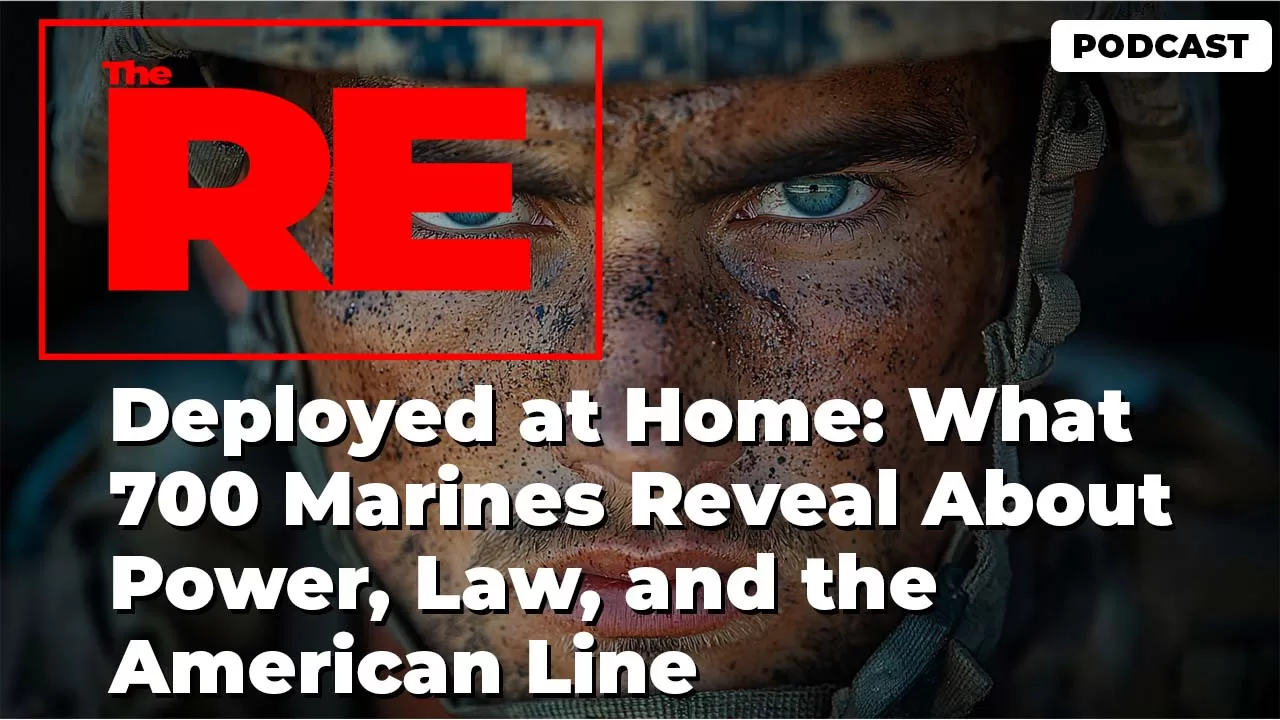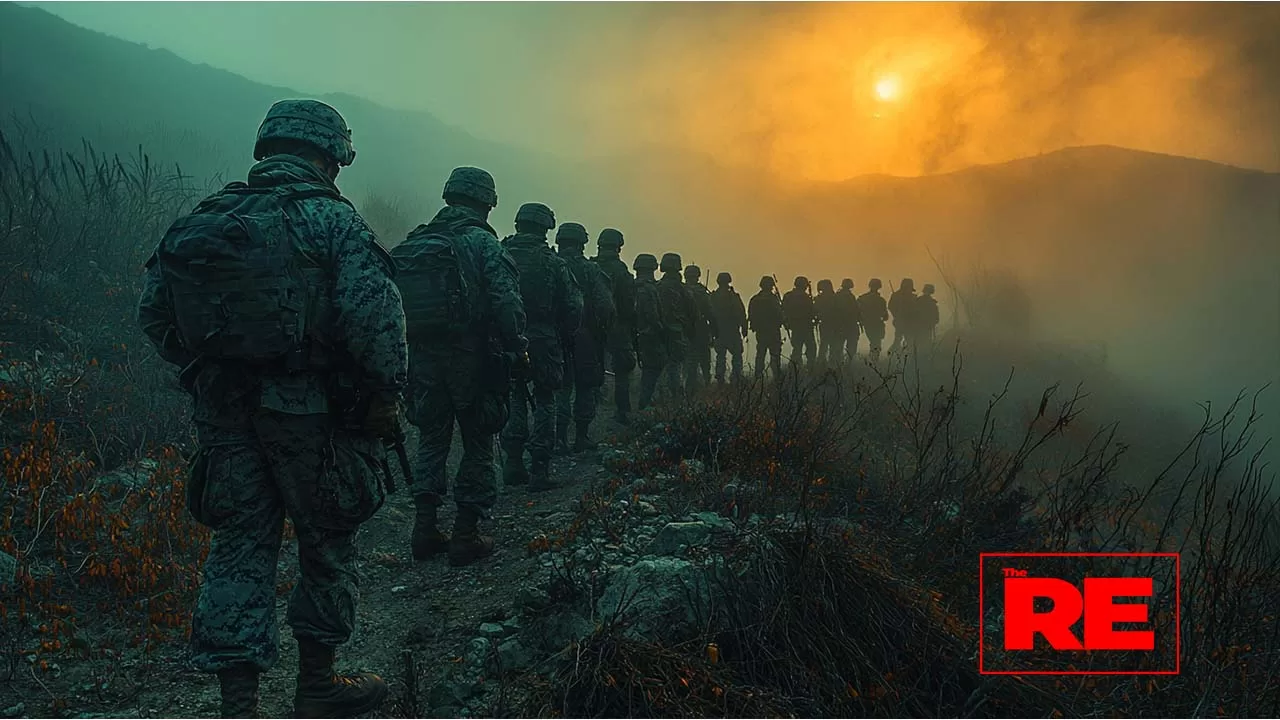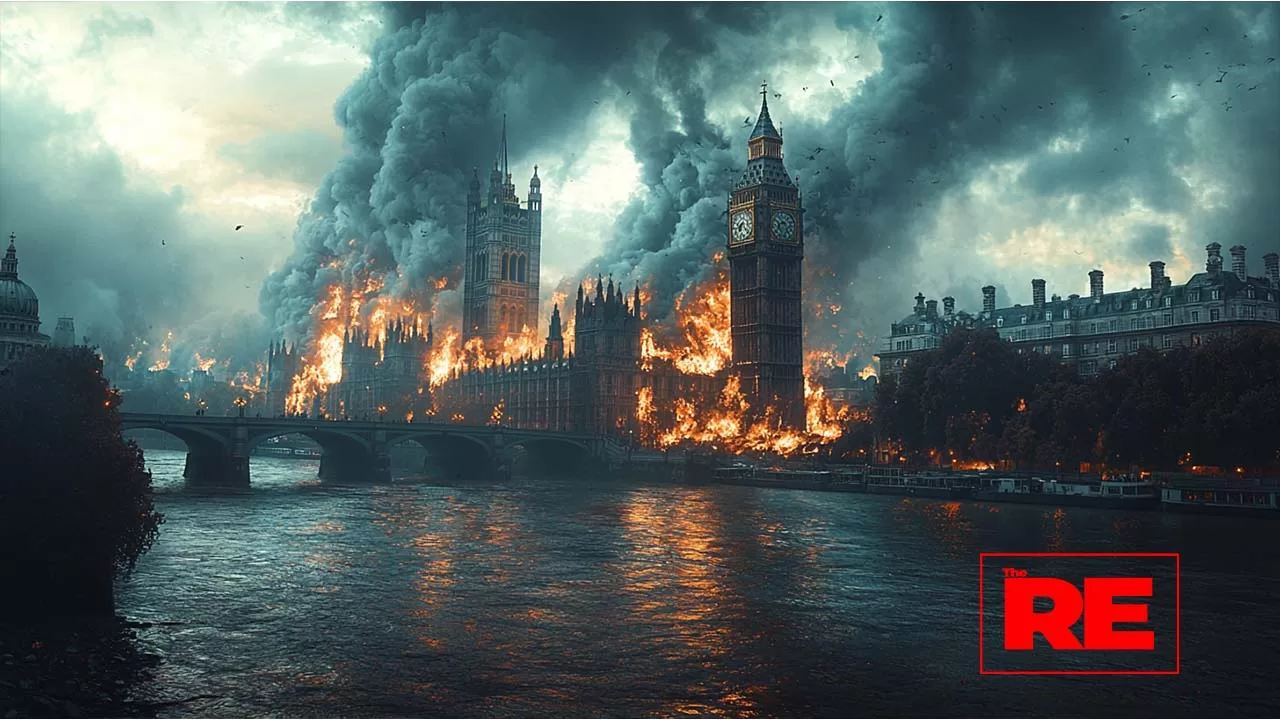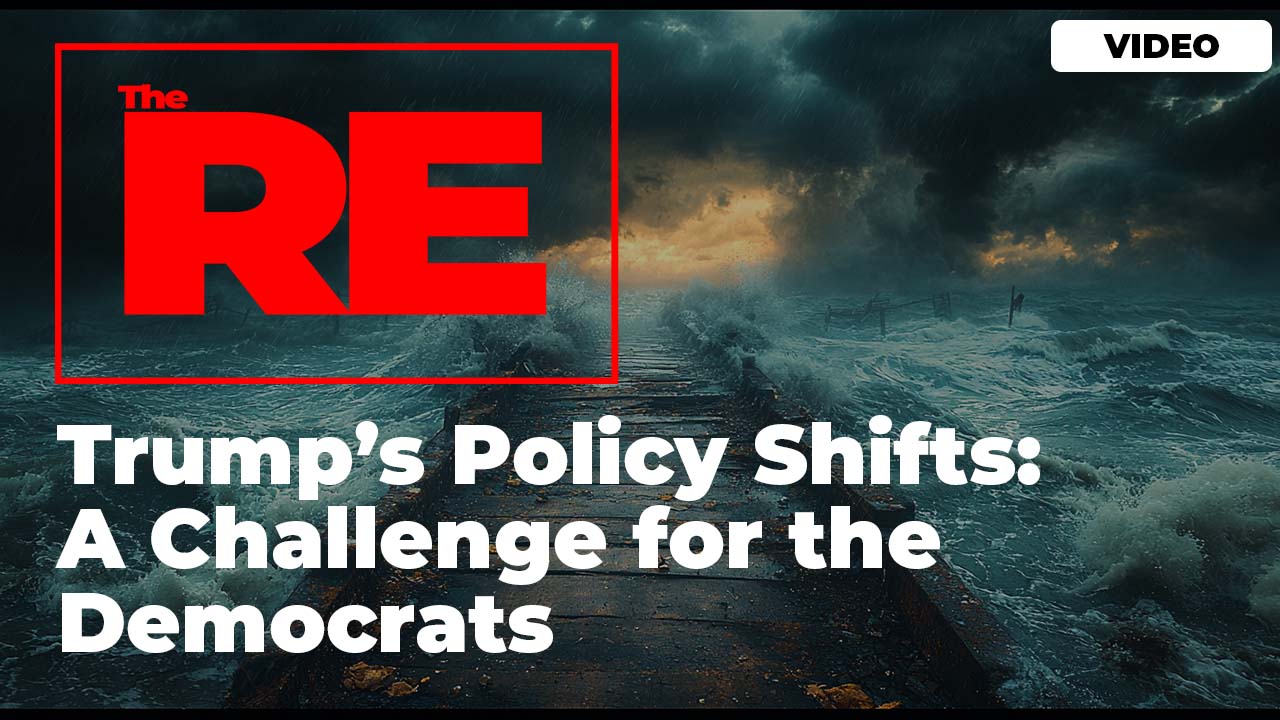The Ripple Effect
-News and Commentary-
Deployed at Home: What 700 Marines Reveal About Power, Law, and the American Line
- Home
- News and Commentary
- Deployed at Home: What 700 Marines Reveal About Power, Law, and the American Line

This is not breaking news. We don't report the news. We Unpack it. Explain it. And analyze what it means.
Click this button to add us to your home screen.
We Unpack. You Decide. Stay informed.
One voice. One message. One Goal. Truth
I saw the headline and paused. “700 Marines deployed to California.” No context. No explanation. Just a flash alert with more heat than clarity.
Then I jumped over to Facebook and it was already a mess. One post called it illegal. Another said it proves we’re being invaded. Then came the usual flood of Constitution quotes from folks who never cared about Article anything until now.
But most of the noise had one thing in common: it was wrong. Not because people are dumb. Because nobody ever broke this down for them in plain language. So let’s do that now. No drama. No politics. Just the framework. The actual rules.
The first thing we need to talk about is Title 10. This is the part of U.S. law that governs the use of federal military forces. When someone says the president is calling in the military, this is usually the bucket they’re reaching into. Title 10 allows the federal government to activate military branches, including the Marines—under direct command of the President or Secretary of Defense. It’s what kicks in when there’s a war, a major federal emergency, or a large-scale operation requiring national coordination.

Then there’s Title 32, which is different. Title 32 covers the National Guard, but under state control with federal funding. In other words, a governor can use their own Guard troops for local emergencies, like hurricanes or riots, and the federal government picks up the tab. The troops wear the uniform, but they’re still operating as part of the state.
Now here’s the part that gets people twisted: Posse Comitatus. This law goes all the way back to 1878, and it basically says that the U.S. military can’t be used as a domestic police force. You can’t have soldiers walking your streets doing traffic stops, arresting civilians, or running surveillance without strict, specific exceptions. That law was written to keep the military from turning into a federal police state. It’s about separation—defense abroad vs. policing at home.
But there are exceptions. And that’s where the Insurrection Act comes in. This law is the loophole, written into the same code, that says in extreme circumstances—like rebellion, invasion, or when local law enforcement can’t maintain order—the President can bypass Posse Comitatus and use active-duty military on American soil. It’s rare. It’s controversial. But it’s legal.
Trump’s decision to deploy 700 Marines to California wasn’t pulled out of thin air. It’s part of a broader narrative he’s pushing—one where immigration is painted as a threat big enough to justify military force. Whether you agree with the move or not, the legality of it depends entirely on how the deployment is structured. If those Marines are under Title 10 authority and being used in support roles—not policing or arresting—it may be completely lawful. If it veers into boots-on-the-ground enforcement, that’s where it crosses lines.
This is where people get stuck: they hear “military” and assume it must be illegal. But the legal framework is built for flexibility. And that’s exactly what’s being tested right now. What makes this moment risky isn’t just the deployment—it’s the precedent. Once you start using active-duty military to address civilian issues like immigration, you blur the lines between national defense and domestic control.
And history tells us once that line is crossed, it’s hard to walk it back.
So yes, it’s complicated. Yes, there are legitimate legal questions. But if we’re going to argue about it, let’s at least be arguing from a place of truth—not panic. That’s the point of The Truth Project. No spin. Just structure. And the clarity to make sense of the chaos.
Let’s dig deeper.

This deployment didn’t happen in a vacuum. It came right after a wave of headlines about increased border crossings and alleged cartel activity leaking into southern California. It plays directly into Trump’s campaign narrative that immigration equals chaos. But legally, the use of Marines under Title 10 means something specific, they are under federal control, not local authority. That distinction matters. A lot.
Federal troops under Title 10 can support border patrol with logistics, construction, intel, and even surveillance, but they cannot make arrests or act as law enforcement without invoking the Insurrection Act. That’s the firewall. And if you don’t see that line clearly, it’s easy to confuse support with suppression.
Now let’s talk history.
The Posse Comitatus Act was signed in 1878, largely as a reaction to the Reconstruction era. After the Civil War, federal troops were used across the South to enforce new laws and civil rights protections. White Southern leaders didn’t like that. So, when they regained power, one of the first things they pushed for was to get the military out of law enforcement. Hence, Posse Comitatus, Latin for “power of the county.” The idea was that civilian law should be enforced by civilian authorities, not soldiers.
Fast forward to today, and the core of that law still stands. But it’s been tested. During Hurricane Katrina, for instance, debates broke out over the use of military assistance when local systems collapsed. After 9/11, the boundaries got even murkier with the introduction of the Patriot Act and growing federal surveillance powers. And during Trump’s presidency, those boundaries were pushed harder than they’ve been in decades.
So here we are again. Another test. Another chapter in the ongoing question: Who gets to use force on U.S. soil, and under what conditions?

And let’s not forget optics. When the public sees Marines in uniform standing on American streets, even if they’re just there for support, it sends a message. Whether intentional or not, it creates the perception of martial control. And perception, in politics, is half the game.
This is why it matters how we talk about this stuff. Language matters. Framework matters. Most people aren’t reading the fine print in the U.S. Code. They’re scrolling headlines, reacting to soundbites, and building their opinions based on emotion, not structure.
So we’re going to keep walking through it. Piece by piece. Not to push fear or praise. But to pull back the curtain and explain the machine.
Because when power moves like this, you better understand the blueprint. That’s the only way to know whether it’s being followed—or rewritten in real time.
But here’s the deeper issue: once you start normalizing military deployment for political optics, you invite abuse.
And I don’t say that lightly. Because we’ve seen this pattern before. Not just in the U.S., but globally, leaders flexing military muscle to stir fear, distract from policy failures, or appear “tough” right before an election cycle. It works. People feel like something is being done. But it also chips away at the wall that’s supposed to separate political agendas from military operations.
And that wall matters. Without it, you start confusing patriotism with obedience. You start teaching the public to expect soldiers instead of solutions. The more you lean on uniforms to solve social issues, whether it’s immigration, protests, or public safety, the less you’re using policy, community, or law.
We saw this in D.C. in 2020. Peaceful protesters in Lafayette Square were met with tear gas and military police. Not because it was necessary—but because the image made a point. That’s the danger here. It’s not always about law. Sometimes, it’s about the message.
And that brings us to now. Whether you support Trump’s move or not, the truth is that this moment is being engineered to trigger reaction. Fear drives engagement. Engagement drives power. And the people caught in the middle—immigrants, military families, everyday citizens—are being used as props in a much bigger stage play. So what do we do with that? We stay grounded. We keep asking real questions. Not just “is this legal?” but “is this healthy?” Not just “can the president do this?” but “should any president normalize this?”
This isn’t about left or right. It’s about how close we let the military come to our front doors before we stop and say, “enough.”
Because once the boots are on the ground, it’s already too late to ask where the line was. Let’s stop pretending this is just about California, or just about immigration, or just about Trump. It’s not. This is about how power moves and who notices when it does.

Because what we’re watching isn’t a one-off decision. It’s a pattern. And patterns don’t start big and loud. They start subtle. They start with headlines you scroll past. With language that sounds reasonable. With moves that feel like “just a precaution.” And by the time the pattern becomes clear, it’s already policy. It’s already precedent. And you’re already too late to push back.
Deploying 700 Marines under Title 10 might be technically legal. But legality has never been the full measure of right and wrong. Jim Crow was legal. Japanese internment was legal. Slavery was legal. The point is: legality is a floor, not a ceiling. It tells you what’s allowed, not what’s just.
And when you keep lowering the bar for what’s allowed, don’t act surprised when people stop looking up.
Let’s be honest. A lot of Americans are numb. Not stupid, numb. We’ve had so much political noise, culture war hype, scandal, violence, and chaos thrown at us over the last 8–10 years that it’s easy to let your guard down. Easy to just assume that “this must be normal now.” And that’s the trap.
Because while we’re distracted, the rules are being bent. Rewritten. Or just ignored.
And we feel it. Even if we don’t always have the words. We feel it in the rise of conspiracy thinking. We feel it in the tribal energy behind every news story. We feel it in the growing sense that the government isn’t neutral anymore, t’s either a savior or an enemy, depending on your side. That’s a dangerous place to be. Not because disagreement is bad—but because shared reality becomes impossible.
So let’s bring it back to the Marines.
Ask yourself why this decision was made now. Why 700 Marines. Why California. Why this language. Why this timing. Because the truth is, this isn’t about solving the border crisis. If that were the case, there’d be a coordinated strategy across federal and state lines, involving housing, asylum, processing, enforcement, and community resources. But there’s no real plan. Just a show of force. You don’t fix immigration with uniforms. You fix it with infrastructure.

But this isn’t about fixing. It’s about signaling. It’s about sending a message that says “we’re in control,” even if the reality on the ground is the same chaos as before. That’s the playbook. Perform control. Project power. Pretend solutions.
And it works. Because it taps into fear. It gives people the illusion that something is being handled, when in truth, nothing structural has changed. The only thing that’s shifted is the threshold for how comfortable we are seeing the military involved in domestic life.
And here’s where that slope gets slippery. Today, it’s Marines on the border. Tomorrow, it’s soldiers assisting during “election security.”
Or standing by during “protests.”
Or “protecting” polling locations.
Or being “on hand” for “civil unrest” after a controversial court ruling.
You see how that logic builds? You don’t need to be paranoid to connect those dots. You just need to look at history.
Because once something is normalized, it’s no longer questioned. And the people in power, any party, any president start reaching for that tool more often. Because it works. And because we’ve stopped asking them why. That’s the danger of this moment. Not the deployment itself. But the silence around it.
Look around. Where’s the outrage? Where’s the press conference from Congress? Where’s the bipartisan pushback saying, “Hey, let’s pause and talk about the implications of this”? Nowhere. And that tells you everything. We’ve reached a place where the military can be deployed on U.S. soil, with almost no public debate, and half the country just shrugs. That should scare you. Not because it means tanks in the streets tomorrow. But because it means we’ve lost track of the guardrails. The military was never meant to be a tool for domestic political theater. It was meant to defend the country, not define it.
And the longer we confuse those roles, the easier it becomes to rewrite the rules in plain sight.
Here’s what makes this even more complicated: the military isn’t the villain here. Most soldiers, Marines, and officers don’t want to be involved in domestic issues. They signed up to serve, not to be pawns in a partisan chess game. But they don’t write the orders—they follow them. That’s the chain of command.
So the responsibility doesn’t fall on the boots on the ground. It falls on us.
On the press to ask better questions.
On the public to stop getting distracted by the drama and start paying attention to the structure.
On leaders—if there are any left who still care about the republic more than reelection, to say: “enough.”
Because this isn’t a red state vs. blue state issue. This is a power vs. people issue. And if we’re not careful, we’re going to wake up one day and realize that we’re living in a country that still feels like a democracy—but no longer functions like one.
So what do we do?
We do what The Truth Project was built to do.
We explain.
We strip the emotion.
We walk people through the systems.
We make the invisible rules visible again.
Because once you see how power works—how it moves, how it hides, how it justifies itself—you can’t unsee it. And that’s when you stop being a spectator and start being a force. This isn’t about being anti-military. This is about being pro-boundaries. Because when it comes to government power, boundaries aren’t suggestions. They’re the only thing that keeps authority in check.
And when those boundaries blur, your rights are the first thing to fade.

Here’s the thing about power: it never disappears. It just shifts. Sometimes quietly. Sometimes violently. But it always moves. And the people who survive those shifts, the ones who stay grounded when the ground is shaking, are the ones who saw it coming. Not because they were prophets. But because they were paying attention.
We’ve reached a point in American history where we have to start asking harder questions. Not about what’s legal. But about what’s sustainable. Not just what’s possible, but what’s wise. Because what we’re watching with these deployments—what we’ve watched for years now across politics, media, law enforcement, surveillance, and public trust, is a slow but steady unraveling of institutional clarity. Everything’s getting murkier. Meaner. More performative. Less principled. And the truth is, empires don’t usually explode.
They erode.
The Roman Empire didn’t fall in one night. It rotted from within while pretending to still be golden. The Ottomans, the Macedonians, the British, all of them had a season where their power seemed inevitable. Permanent. Unshakeable. Until it wasn’t. Most empires last about 200 years at their peak. Not forever, just long enough to feel like they’ll never fall. Every few generations, the world resets. Not because anyone planned it that way, but because power doesn’t care about your traditions. It only respects leverage. And if you lose that, economically, morally, globally, it moves on.
So where does that leave us?
Is America still the empire? The leader of the free world? The model of democracy? Or are we watching the slow start of something else—a shift toward a new global order where our grip loosens and another nation steps up? I don’t know. Nobody does. But I know the signs. And this is one of them.
When you see a nation start using military power to fix civilian problems, that’s not strength, that’s desperation. That’s a government trying to force order because it can’t earn trust. That’s what countries do when the center can’t hold and the system starts eating itself. This isn’t a left or right issue. This is a collapse-of-consensus issue.
And collapse doesn’t always look like chaos. Sometimes it looks like control. Like curfews and checkpoints. Like “emergency authorizations.” Like “temporary measures” that slowly become permanent. Not because someone’s twirling a villain’s mustache behind the scenes, but because we let too much slide. We made too many excuses. We got too tired to keep watch. This moment matters. Not because of what happens this week, but because of what becomes possible next month. Next year. Next administration.
Once the military is treated like a solution, every crisis becomes an excuse.
A protest becomes a threat.
A policy debate becomes a national emergency.
An election becomes a security risk.
And the machine starts running on fear instead of law.
So what do we do now?
We remember that the American experiment was never guaranteed. It was an idea. One that only works if people believe in it enough to defend it—not just with flags and slogans, but with discipline. With truth. With real checks and balances, even when it’s inconvenient.
That’s what The Truth Project is about.
It’s not about outrage.
It’s about clarity.
It’s about helping people spot the shift before it becomes a slide. Because if this really is the beginning of a new chapter in the American story—whether that means reform or reckoning or something we can’t yet name—then the job now isn’t to pick sides. It’s to stay awake.
And if nothing else, let this be the moment where we stop waiting for someone else to sound the alarm.
Because it’s already ringing.
This is not breaking news. We don't report the news. We Unpack it. Explain it. And analyze what it means.
Click this button to add us to your home screen.
We Unpack. You Decide. Stay informed.
One voice. One message. One Goal. Truth





 and then
and then